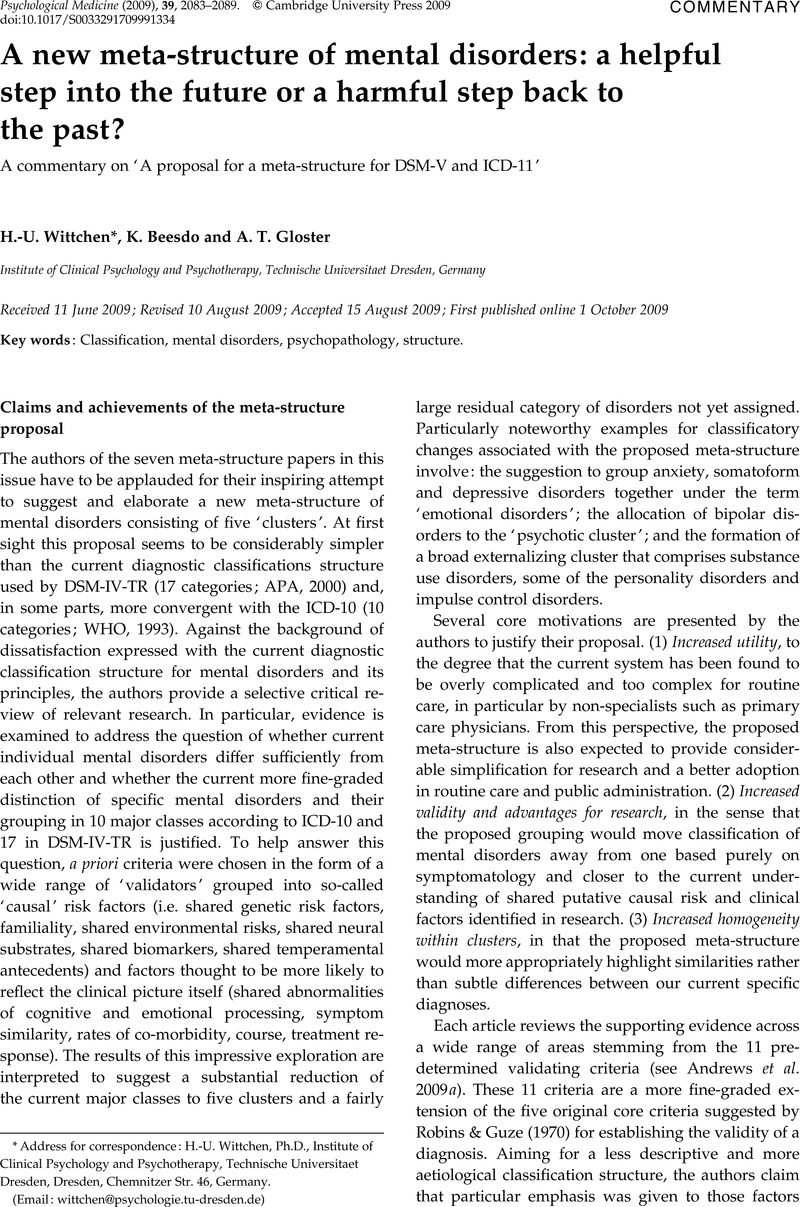Crossref Citations
This article has been cited by the following publications. This list is generated based on data provided by Crossref.
Wittchen, Hans‐Ulrich
Beesdo‐Baum, Katja
Gloster, Andrew T.
Höfler, Michael
Klotsche, Jens
Lieb, Roselind
Beauducel, André
Bühner, Markus
and
Kessler, Ronald C.
2009.
The structure of mental disorders re‐examined: Is it developmentally stable and robust against additions?.
International Journal of Methods in Psychiatric Research,
Vol. 18,
Issue. 4,
p.
189.
Pierre, Joseph M.
2010.
The Borders of Mental Disorder in Psychiatry and the DSM.
Journal of Psychiatric Practice,
Vol. 16,
Issue. 6,
p.
375.
Kessler, Ronald C
Petukhova, Maria
and
Zaslavsky, Alan M
2011.
The role of latent internalizing and externalizing predispositions in accounting for the development of comorbidity among common mental disorders.
Current Opinion in Psychiatry,
Vol. 24,
Issue. 4,
p.
307.
Vaidyanathan, Uma
Patrick, Christopher J.
and
Iacono, William G.
2011.
Patterns of comorbidity among mental disorders: a person-centered approach.
Comprehensive Psychiatry,
Vol. 52,
Issue. 5,
p.
527.
Kessler, Ronald C.
Cox, Brian J.
Green, Jennifer Greif
Ormel, Johan
McLaughlin, Katie A.
Merikangas, Kathleen Ries
Petukhova, Maria
Pine, Daniel S.
Russo, Leo J.
Swendsen, Joel
Wittchen, Hans-Ulrich
and
Zaslavsky, Alan M.
2011.
The effects of latent variables in the development of comorbidity among common mental disorders.
Depression and Anxiety,
Vol. 28,
Issue. 1,
p.
29.
Roberts, Michael C.
Reed, Geoffrey M.
Medina-Mora, María Elena
Keeley, Jared W.
Sharan, Pratap
Johnson, David K.
Mari, Jair de Jesus
Ayuso-Mateos, José Luis
Gureje, Oye
Xiao, Zeping
Maruta, Toshimasa
Khoury, Brigitte
Robles, Rebeca
and
Saxena, Shekhar
2012.
A global clinicians’ map of mental disorders to improve ICD-11: Analysing meta-structure to enhance clinical utility.
International Review of Psychiatry,
Vol. 24,
Issue. 6,
p.
578.
Reed, Geoffrey M.
Roberts, Michael C.
Keeley, Jared
Hooppell, Catherine
Matsumoto, Chihiro
Sharan, Pratap
Robles, Rebeca
Carvalho, Hudson
Wu, Chunyan
Gureje, Oye
Leal‐Leturia, Itzear
Flanagan, Elizabeth H.
Correia, João Mendonça
Maruta, Toshimasa
Ayuso‐Mateos, José Luís
de Jesus Mari, Jair
Xiao, Zeping
Evans, Spencer C.
Saxena, Shekhar
and
Medina‐Mora, María Elena
2013.
Mental Health Professionals’ Natural Taxonomies of Mental Disorders: Implications for the Clinical Utility of the ICD‐11 and the DSM‐5.
Journal of Clinical Psychology,
Vol. 69,
Issue. 12,
p.
1191.
Regier, Darrel A.
Kuhl, Emily A.
and
Kupfer, David J.
2013.
The DSM‐5: Classification and criteria changes.
World Psychiatry,
Vol. 12,
Issue. 2,
p.
92.
Knappe, S.
Klotsche, J.
Strobel, A.
LeBeau, R.T.
Craske, M.G.
Wittchen, H.-U.
and
Beesdo-Baum, K.
2013.
Dimensional anxiety scales for DSM-5: Sensitivity to clinical severity.
European Psychiatry,
Vol. 28,
Issue. 7,
p.
448.
Wittchen, H.-U.
Heinig, I.
and
Beesdo-Baum, K.
2014.
Angststörungen im DSM-5.
Der Nervenarzt,
Vol. 85,
Issue. 5,
p.
548.
Beesdo-Baum, Katja
and
Wittchen, Hans-Ulrich
2015.
International Encyclopedia of the Social & Behavioral Sciences.
p.
179.
Beesdo-Baum, Katja
Knappe, Susanne
Asselmann, Eva
Zimmermann, Petra
Brückl, Tanja
Höfler, Michael
Behrendt, Silke
Lieb, Roselind
and
Wittchen, Hans-Ulrich
2015.
The ‘Early Developmental Stages of Psychopathology (EDSP) study’: a 20-year review of methods and findings.
Social Psychiatry and Psychiatric Epidemiology,
Vol. 50,
Issue. 6,
p.
851.
Cooper, Rachel
2018.
Understanding the DSM-5: stasis and change.
History of Psychiatry,
Vol. 29,
Issue. 1,
p.
49.
Wittchen, Hans‐Ulrich
and
Beesdo‐Baum, Katja
2018.
“Throwing out the baby with the bathwater”? Conceptual and methodological limitations of the HiTOP approach.
World Psychiatry,
Vol. 17,
Issue. 3,
p.
298.
Stinson, Catherine
2019.
The absent body in psychiatric diagnosis, treatment, and research.
Synthese,
Vol. 196,
Issue. 6,
p.
2153.
Frangou, Sophia
2021.
Brain Network Dysfunction in Neuropsychiatric Illness.
p.
455.



